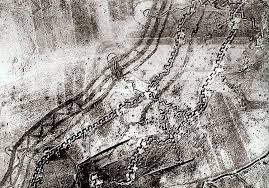Search
- Home
- Search
Search results for Hindenburg Line.
29 September 1918 : L Cpl John Wade
/on-this-day/29-september-1918-l-cpl-john-wade/
John was a warehouseman at Woodward's Mill, Burnley, Lancashire before the war, John was conscripted into service in April 1916, he initially served on the Western Front with the DCLI with whom, as Private 27452, he was wounded three times. After convalescing back in the UK following his third wounding, John was transferred to the 12th Glosters…
096: January 2013
Download PDF This browser does not support inline PDFs. Please download the PDF to view it: Download PDF
The Final One Hundred Days of the Western Front
/world-war-i-articles/the-final-one-hundred-days-of-the-western-front/
Introduction The British involvement in war on the Western Front lasted for 1,294 days: from the 12th of August 1914 - when the first elements of the British Expeditionary Force (BEF) arrived in France - until the 11th November 1918, when the Armistice took effect. For each of those days an average of 1,751 men were wounded and 436 died (the latte…
Arthur Boyle Private and Pensioner
/world-war-i-articles/arthur-boyle-private-and-pensioner/
Painting by Diane Lavery 1998 from a photograph of Arthur Boyle taken in 1917 Arthur Boyle, born in 1894, from Castlemaine in Co. Kerry, volunteered to serve in the South Irish Horse on 25 January 1917. He was one of over 200,000 Irish men who volunteered to serve in the British army in the First World War. The great majority came from what i…
Commemorating the restoration of the Riqueval Bridge Memorial
/latest-news/2018/september-2018/commemorating-the-restoration-of-the-riqueval-bridge-memorial/
In glorious weather on the once British-held part of the Western Front, Western Front Association Chairman Colin Wagstaff and WFA European Officer Any Tongue took part alongside VIPs, dignitaries and guests in the rededication of the Riqueval Bridge Memorial. (Next to the newly rededicated Riqueval Bridge Memorial) In attendance were the great …
113: October 2018 Special Edition
/stand-to/113-october-2018-special-edition/
Download PDF
This browser does not support inline PDFs. Please download the PDF to view it: Download PDF
Ep. 48 – The Hindenburg Line – Clive Harris
/the-latest-wwi-podcast/ep-48-the-hindenburg-line-clive-harris/
Military historian and battlefield guide Clive Harris, Director of Battle Honours, discusses the Hindenburg Line during the First World War.

Crossing the Devastated Zone, 1917: Lessons and Consequences for the British Expeditionary Force by Rob Thompson
The German withdrawal to the Hindenburg Line, 14 March – 5 April, 1917, is something of a footnote in the study of Great War military operations yet the engineering and logistic lessons taught were of crucial importance to the success of BEF mobile operations in 1918. It represented the BEF’s only experience of a mobile pursuit against an enemy re…
Gott Strafe England
/world-war-i-articles/gott-strafe-england/
The 'withdrawal to the Hindenburg Line' of February 1917 enabled allied troops to occupy previously German-held towns and villages. The advance was not easy, the Germans left behind booby traps and other 'presents' that would today be termed 'IEDs' (Improvised Explosive Device). Following a 'scorched earth policy' they also reportedly cut down orch…
ONLINE: Breaking the Hindenburg Line - The assault by the 137 (Staffordshire) Brigade on 29 September 1918
The presentation will be live and online. One of the most iconic photographs of the Great War is that of the Territorials of 137 (Staffordshire) Brigade lining the eastern bank of the St Quentin Canal while being addressed by their Brigade Commander, Brigadier John Campbell VC, from the rampart of the Riqueval Bridge. Beyond the photographs of mu…
Ep. 199 - New York’s Silkstocking Regiment and the Breaking of the Hindenburg Line - Stephen L. Harris.
American historian and author Stephen L. Harris talks about his book recent book Duty, Honor, Privilege that looks at the New York’s Silk Stocking Regiment and how it ‘broke’ the Hindenburg Line in 1918. Your browser does not support the audio element. …
Ep.200 - Logistics during the Messines - Third Ypres Campaign - Rob Thompson
/the-latest-wwi-podcast/ep200-logistics-during-the-messines-third-ypres-campaign-rob-thompson/
In this Mentioned in Dispatches podcast, historian Rob Thompson talks about what got him interest in the First World War, and how he became fascinated by a subject so many others found boring - logistics. He then weaves together a narrative that shows how successful 'logistics', known only as 'supply and transport' at the time, fed the BEF munition…
ONLINE: A fine feat of War: The taking of Mont St Quentin 1918 by Julian Whippy
/events/online-a-fine-feat-of-war-the-taking-of-mont-st-quentin-1918-by-julian-whippy/
The presentation will be live and online. After the Allied successes of 8 August 1918 there was a series of hammer blows against the retreating Germans. However, by the end of that month the assaulting forces were weakened themselves and decidedly footsore. Ahead lay the brooding hill of Mont St Quentin which commanded views of Peronne town and t…
Two Day Event at Joncourt - A Tribute to Wilfred Owen
/events/two-day-event-at-joncourt-a-tribute-to-wilfred-owen/
On the 1st October 1918, the 32nd Division was tasked with capturing Joncourt and the Beaurevoir-Fonsomme Line (Hindenburg Support Line) to the north-east of the village. After Joncourt had been captured, advancing with the 2nd Manchesters, Second Lieutenant Wilfred Edward Salter Owen took command of D Company after it’s commander was wounded, capt…





